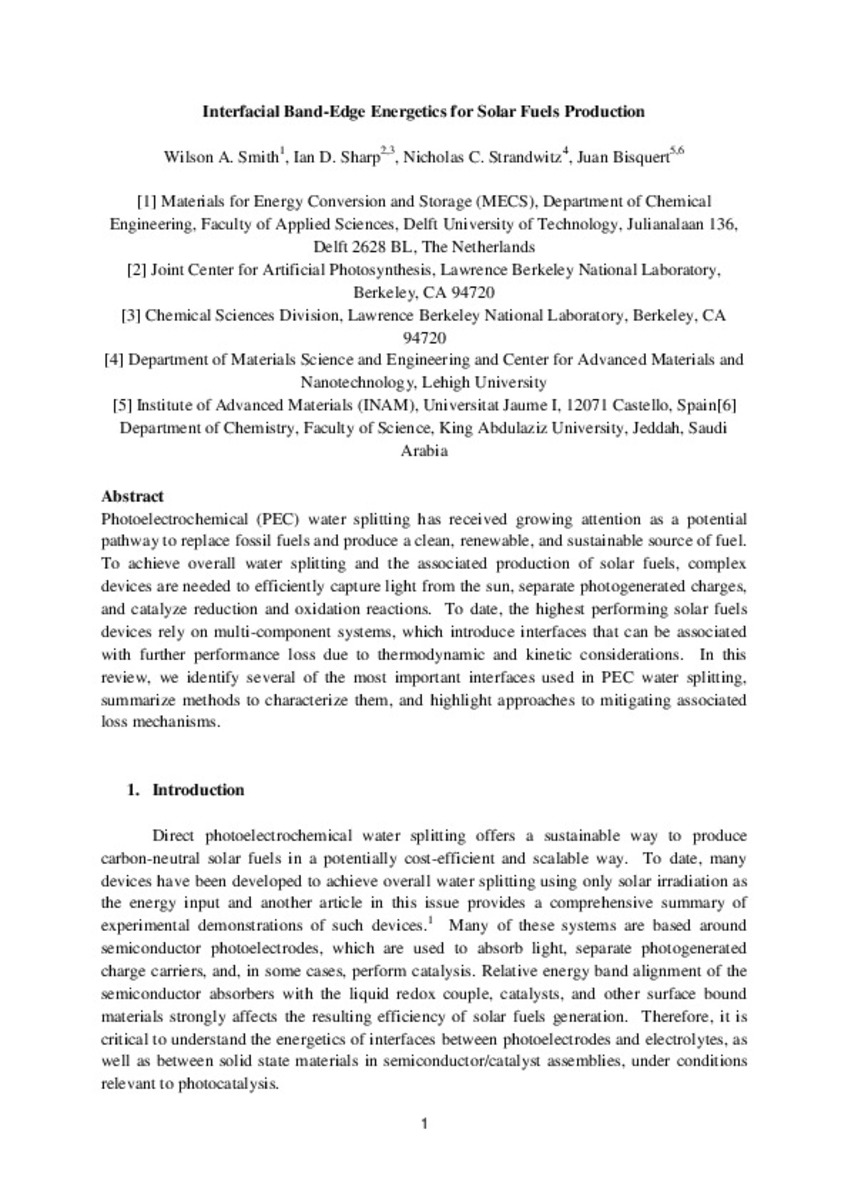Mostrar el registro sencillo del ítem
Interfacial band-edge energetics for solar fuels production
| dc.contributor.author | Smith, Wilson A. | |
| dc.contributor.author | Sharp, Ian D. | |
| dc.contributor.author | Strandwitzd, Nicholas C. | |
| dc.contributor.author | Bisquert, Juan | |
| dc.date.accessioned | 2016-06-07T15:01:52Z | |
| dc.date.available | 2016-06-07T15:01:52Z | |
| dc.date.issued | 2015 | |
| dc.identifier.issn | 1754-5692 | |
| dc.identifier.issn | 1754-5706 | |
| dc.identifier.uri | http://hdl.handle.net/10234/160414 | |
| dc.description.abstract | Photoelectrochemical (PEC) water splitting has received growing attention as a potential pathway to replace fossil fuels and produce a clean, renewable, and sustainable source of fuel. To achieve overall water splitting and the associated production of solar fuels, complex devices are needed to efficiently capture light from the sun, separate photogenerated charges, and catalyze reduction and oxidation reactions. To date, the highest performing solar fuels devices rely on multi-component systems, which introduce interfaces that can be associated with further performance loss due to thermodynamic and kinetic considerations. In this review, we identify several of the most important interfaces used in PEC water splitting, summarize methods to characterize them, and highlight approaches to mitigating associated loss mechanisms. | ca_CA |
| dc.description.sponsorShip | The authors thank Dr Eric Miller for the inspiration to compile this review, and the members of the U.S. Department of Energy’s Photoelectrochemical Working Group and Task 35 (Renewable Hydrogen) of the International E nergy Agency’s Hydrogen Imple- menting Agreement for helpful comments, suggestions, and dis- cussions, specifically Prof. Shane Ardo, Dr John Turner, Prof. Dunwei Wang, and Prof. Shannon Boettcher. WAS greatly acknowl- edges funding support from the FOM/NWO/Shell Program on CO 2 - neutral Fuels (Project – APPEL). IDS was supported by the Joint Center for Artificial Photosynthesis, a DOE Energy Innovation Hub, supported through the Office of Science of the U.S. Department of Energy under Award Number DE-SC0004993. NCS acknowledges start-up funds from Lehigh University. JB thanks financial support from GeneralitatValenciana (ISIC/ 2012/008). A summary version of this review paper (DOI: 10.2172/1209498), and associated summary tables that will be updated as the field progresses, will be available on the working group website (http://energy.gov/eere/fuelcells/ photoelectrochemical-working-group). | ca_CA |
| dc.format.extent | 13 p. | ca_CA |
| dc.format.mimetype | application/pdf | ca_CA |
| dc.language.iso | eng | ca_CA |
| dc.publisher | Royal Society of Chemistry | ca_CA |
| dc.relation.isPartOf | Energy & Environmental Science, 2015, vol. 8, núm. 10 | ca_CA |
| dc.rights | This journal is © The Royal Society of Chemistry 2015 SMITH, Wilson A., et al. Interfacial band-edge energetics for solar fuels production. Energy & Environmental Science, 2015, vol. 8, no 10, p. 2851-2862. <http://dx.doi.org/10.1039/C5EE01822F> -- Reproduced by permission of The Royal Society of Chemistry | ca_CA |
| dc.rights.uri | http://rightsstatements.org/vocab/InC/1.0/ | * |
| dc.subject | Photoelectrochemical cells | ca_CA |
| dc.subject | Loss mechanisms | ca_CA |
| dc.subject | Multi-component systems | ca_CA |
| dc.subject | Oxidation reactions | ca_CA |
| dc.subject | Performance loss | ca_CA |
| dc.title | Interfacial band-edge energetics for solar fuels production | ca_CA |
| dc.type | info:eu-repo/semantics/article | ca_CA |
| dc.identifier.doi | http://dx.doi.org/10.1039/C5EE01822F | |
| dc.rights.accessRights | info:eu-repo/semantics/openAccess | ca_CA |
| dc.relation.publisherVersion | http://pubs.rsc.org/en/Content/ArticleLanding/2015/EE/C5EE01822F#!divAbstract | ca_CA |
| dc.type.version | info:eu-repo/semantics/submittedVersion |
Ficheros en el ítem
Este ítem aparece en la(s) siguiente(s) colección(ones)
-
INAM_Articles [510]
-
FCA_Articles [507]
Articles de publicacions periódiques







